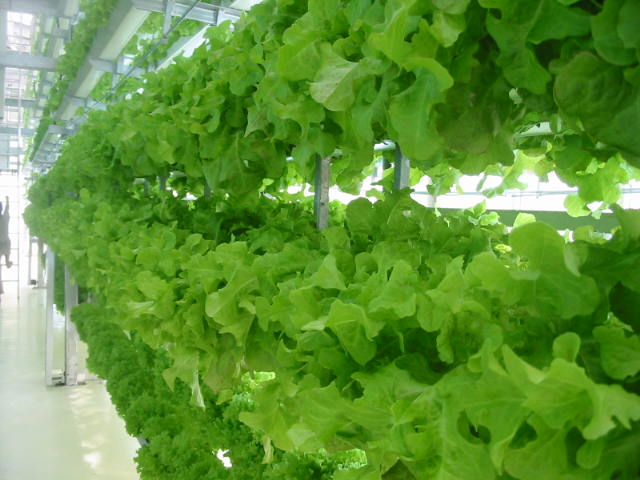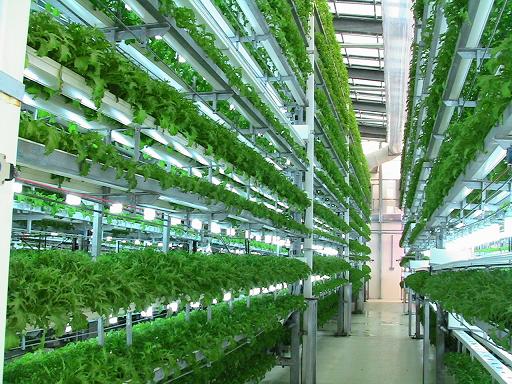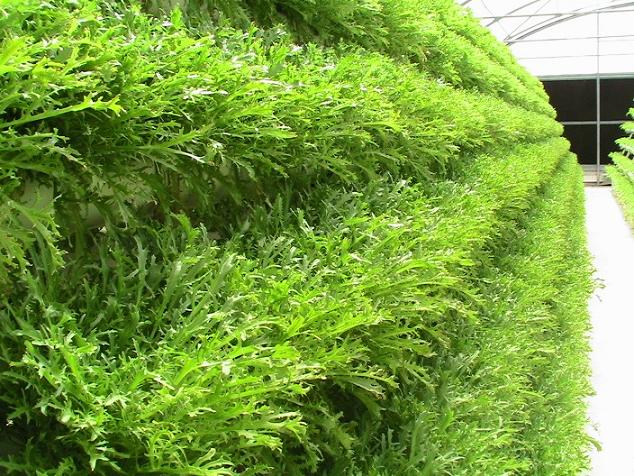Hydroponics
- Ayrıntılar
- Üst Kategori: ROOT
- Kategori: Ecological/Organic Agriculture
The History of Hydroponics
The word hydroponics comes from two Greek words, "hydro" meaning water and "ponics" meaning labor. The concept of soilless gardening or hydroponics has been around for thousands of years. The hanging Gardens of Babylon and The Floating Gardens of China are two of the earliest examples of hydroponics. Scientist started experimenting with soil less gardening around 1950. Since then other countries, such as Holland, Germany, and Australia have used hydroponics for crop production with amazing results.



The Benefits of Hydroponics
Hydroponics is proved to have several advantages over soil gardening. The growth rate on a hydroponic plant is 30-50 percent faster than a soil plant, grown under the same conditions. The yield of the plant is also greater. Scientist believe that there are several reasons for the drastic differences between hydroponic and soil plants. The extra oxygen in the hydroponic growing mediums helps to stimulate root growth. Plants with ample oxygen in the root system also absorb nutrients faster. The nutrients in a hydroponic system are mixed with the water and sent directly to the root system. The plant does not have to search in the soil for the nutrients that it requires. Those nutrients are being delivered to the plant several times per day. The hydroponic plant requires very little energy to find and break down food. The plant then uses this saved energy to grow faster and to produce more fruit. Hydroponic plants also have fewer problems with bug infestations, funguses and disease. In general, plants grown hydroponically are healthier and happier plants.
Hydroponic gardening also offers several benefits to our environment. Hydroponic gardening uses considerably less water than soil gardening, because of the constant reuse the nutrient solutions. Due to lack of necessity, fewer pesticides are used on hydroponic crops. Since hydroponic gardening systems use no topsoil, topsoil erosion isn't even an issue. Although, if agricultural trends continue to erode topsoil and waste water, hydroponics may soon be our only solution.
Growing Mediums
The purpose of a growing medium is to aerate and support the root system of the plant and to channel the water and nutrients. Different growing mediums work well in different types of hydroponic systems. A fast draining medium, such as hydrocorn or baypor works well in an ebb and flow type system. Hydrocorn is a man-made rolled, clay rock. It is a light, airy type of growing medium that allows plenty of oxygen to penetrate the plant's root system. Baypor is a similar rock made mostly of rolled lava. Both types of grow rocks can be reused, although the bay Baypor has more of a tendency to break down and may not last as long as the Hydrocorn. These grow rocks are very stable and rarely effect the pH of the nutrient solution.
Rockwool has become an extremely popular growing medium. Rockwool was originally used in construction as insulation. There is now a horticultural grade of Rockwool. Unlike the insulation grade, horticultural Rockwool is pressed into growing cubes and blocks. It is produced from volcanic rock and limestone. These components are melted at temperatures of 2500 degrees and higher. The molten solution is poured over a spinning cylinder, comparable to the way cotton candy is made, then pressed into identical sheets, blocks or cubes. Since Rockwool holds 10-14 times as much water as soil and retains 20 percent air it can be used in just about any hydroponic system. Although the gardener must be careful of the pH, since Rockwool has a pH of 7.8 it can raise the pH of the nutrient solution. Rockwool cannot be used indefinitely, most gardeners get one use per cube. It is also commonly used for propagation.
Other commonly used growing mediums are perlite, vermiculite and different grades of sand. These three mediums are stable and rarely effect the pH of the nutrient solution. Although, they tend to hold much moisture and should be used with plants that are tolerant to these conditions. Perlite, vermiculite and sands are very inexpensive options, and work charitably in wick systems, although they are not the most effective growing mediums.
Nutrients
Most of the principles that apply to soil fertilizers also apply to hydroponic fertilizers, or nutrient solutions. A hydroponic nutrient solution contains all the elements that the plant normally would get from the soil. These nutrients can be purchased at a hydroponic supply store. Most are Highly concentrated, using 2 to 4 teaspoons per gallon of water. They come in liquid mixes or powered mixes, usually with at least two different containers, one for grow and one for bloom. The liquids are the slightly more expensive and the easiest to use. They dissolve quickly and completely into the reservoir and often have an added pH buffer. The powered varieties are inexpensive and require a little more attention. They need to be mixed much more thoroughly and often don't dissolve completely into the reservoir. Most do not have a pH buffer.
Like soil, hydroponic systems can be fertilized with organic or chemical nutrients. An organic hydroponic system is considerably more work to maintain. The organic compounds have a tendency to lock together and cause pumps blockage. Some hydroponic gardeners simply supplement their hydroponic gardens with organic nutrients, using the chemical nutrients as the main food supply. This gives the plants a stable supply of nutrients without the high maintenance a hydro-organic system.
pH
Most plants can grow hydroponically within a pH range of 5.8 to 6.8, 6.3 is considered optimal. The pH in a hydroponic system is much easier to check than the pH of soil. Many hardware, pet and hydroponic supply stores sell pH testing kits. They range in price from $4.00 to about $15.00, depending on the range and type of test you prefer. Testing pH is easy and essential in a hydroponics system. If the pH is too high or too low the plant will not be able to absorb certain nutrients and will show signs of deficiencies. pH should be checked once a week. It is easy to adjust by adding small amounts of soluble Potash to raise pH, or phosphoric acid to lower pH. There are also several pH meters available. These give a digital reading of the pH in the system. The pH meters costs around $100 and are not necessary in most cases.
Hydroponic Systems
Hydroponic systems are characterized as active or passive. An active hydroponic system actively moves the nutrient solution, usually using a pump. Passive hydroponic systems rely on the capillary action of the growing medium or a wick. The nutrient solution is absorbed by the medium or the wick and passed along to the roots. Passive systems are usually too wet and do not supply enough oxygen to the root system for optimum growth rates.
Hydroponic systems can also be characterized as recovery or non-recovery. Recovery systems or recirculating systems reuse the nutrient solution. Non-recovery means just what it says. The nutrient solution is applied to the growing medium and not recovered.
Hydroponics Systems
Static Aerated Technique (SAT) Also referred to as a Passive Technique. Plants are grown in a depth of static nutrient solution, which is aerated by providing air space in the root zone or by pumping air into the nutrient solution in the tank. This is a basic method of hydroponics.
Ebb and Flow Technique (EFT) Flood & Drain Technique EFT is the same as Static Aerated Technique SAT, but the nutrient solution in drained off 3-4 times a day to permit the roots to breathe.
Deep Flow Technique (DFT) The depth of nutrient solution (4-6 cm) is circulated around the roots either by gravity or by using a pump. This technique is also referred to as Dynamic Root Floatation Technique and as Raceways Hydroponics.
Drip Irrigation Technique (DIT) Grown in inert or organic material and the nutrient solution are fed around the root system 6-7 times a day, in drops or trickles. This technique is called as Drip Fertigation Technique.
Aerated Flow Technique (AFT) A modified version of DFT, the nutrient solution is amply aerated by special mechanisms. The Japanese Kyowa Hyponica Technique is somewhat similar to AFT.
Nutrient Film Technique (NFT) This technique helps the root system with a thin film of nutrient solution which is always in contact with the roots while the nutrient solutions circulates and the root surface is exposed to air.
Root Mist Technique (RMT) A nutrient mist solution is sprayed every 4-5 minutes onto the roots of the plants that hang from frame in a root chamber. This technique is known as Aeroponics. This technique is good for starting roots, cuttings and also for extracting (milking) in the pharmaceutical industry.
Fog Feed Technique (FFT) This technique is similar to RMT but the nutrient solution droplet size is very minute. This technique is good for plants having aerial roots. Example: orchids, anthuriums, etc.
Buying a System or Building a System
This is the most asked question relating to hydroponics. Should I buy one or build one? This author recommends a little of both. If you have an engineering mind and dream of building your own hydroponic system, buy one first! Get an inexpensive system that will allow you to get your feet wet and give you a better understanding of how hydroponics works. The hands on experience is worth the cost of the system and chances are, you will be able to reuse the parts in that system when you set out to build your own.
If you would rather get right into building your own, do your research. Get all the information you can and don't rely on just one source. This is a constantly changing industry and there are many books still on the shelves that are already outdated. Building your own system can be very rewarding or extremely frustrating. It's mostly trail and error so, be patient.
Hydroponic gardening is the wave of the future. It is currently being studied in classrooms around the country, local horticultural societies and in government funded research at major universities and NASA. It is also becoming a popular hobby. Hydroponics is fun, exciting and easy to get involved in.









